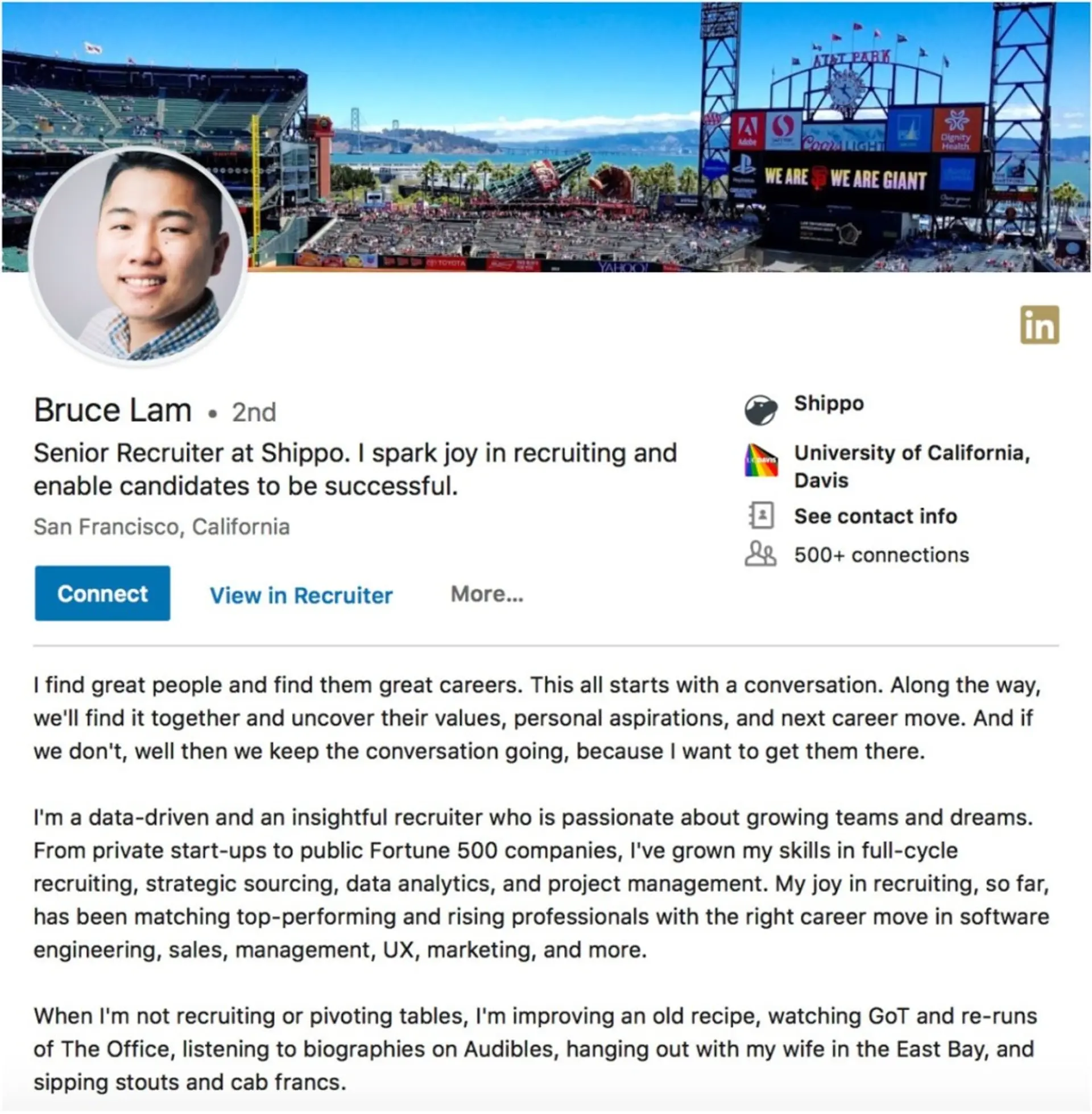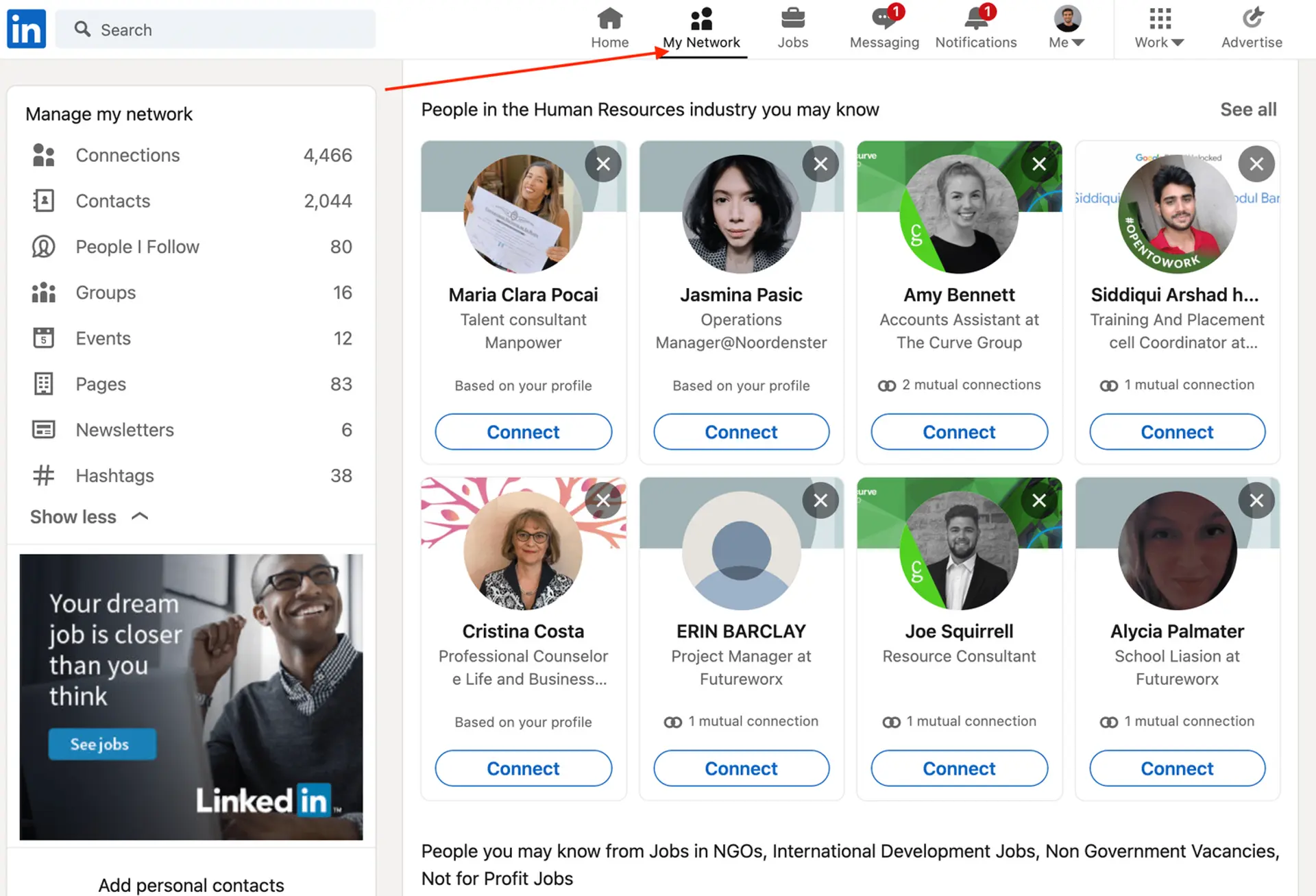
LinkedIn is the world’s largest online professional network, with over 700 million members from 55 million registered companies.
This means that you can use LinkedIn for, well, just about anything related to growing as a professional:
- Connect with potential employers and get a new job.
- Network with experts in your field and develop your skill-set.
- Source and hire candidates for your firm.
- Find a business partner for your next venture.
..And everything else in-between!
Nonetheless, this wide reach doesn’t make connecting with people and networking on LinkedIn an easy process.
Truth is, using LinkedIn can be confusing, especially if you’re just getting started.
After all, the platform doesn’t come with a manual on how you can build a professional description, approach recruiters, gain followers, or foster your professional ties.
...But that’s why we’re here!
In this guide, we’ll be going through 7+ best tips you can use to upgrade your LinkedIn profile, expand your professional connections, and network on LinkedIn like a pro.
7+ Tips on How to Network on LinkedIn
You probably already have a LinkedIn account…
You might even have some connections as part of your network from your last job or university…
But that’s far from everything you can do to take advantage of LinkedIn to build new connections and really take your career to the next level!
In fact, that’s just the tip of the iceberg.
Here are the 7 essential tips you need to follow to become a LinkedIn networking expert:
#1: Complete Your Profile
If you haven’t already, make sure your LinkedIn profile is completely filled out. Meaning, all the sections on your profile are filled in and there are no gaps and blank spaces.
Why? Because LinkedIn prioritizes complete profiles over empty ones.
So, if an employer looks up your job title, you’re more likely to pop up on page #1 if your profile is completely filled out.
Even if this wasn't the case, having a half-filled LinkedIn profile is like having a half-page resume.
Anyone that visits your profile is going to think that you just don't have much to say about yourself professionally.
So, make sure to add the following sections to your LinkedIn profile:
- A headline
- A profile photo and background picture
- A LinkedIn summary
- Current job title
- Your country and zip code
- Work experience with relevant dates
- Education section
- Any volunteer work or other hobbies
- At least 5 relevant skills
#2: Optimize Your Profile
Filling up your LinkedIn profile is only step #1. If, however, you want to stand out from thousands of other applicants on the platform, you also have to optimize it.
So, implement these tips when making your LinkedIn profile to build the best possible personal brand for yourself:
Add a Professional-Looking, Friendly Profile Picture
As a rule of thumb, pick a high-quality picture where you look neat and clean, smiling, and located near the camera. If possible, consider getting your professional headshot taken.
Add an Effective Headline
Your LinkedIn headline helps you do two main things: show up in recruiters’ LinkedIn searches and show them what you’re up to in an instant.
Here are some tips that’ll help you pick the right headline keywords for your situation:
- Find the exact jobs you’re interested in. Go to LinkedIn’s Job Board and filter your search by experience level, job type, geography, etc. Sift through the search results and choose a number of roles you’re interested in.

- Continue by looking for the words and phrases that appear most frequently across these headlines. These are the keywords that recruiters use to find possible candidates.
- Use these keywords when creating your headline. So, for example, let’s say you’re searching for an entry-level job as a data scientist in Tech. Keywords for this position include Analytics, Business Intelligence, Data Science, Data Scientist, Data Engineer, Data Modeling, and Computer Science. Here’s a potential LinkedIn headline you can use:
“Data Engineer actively looking for new opportunities in Analytics, Business Intelligence and Data Science.”
Create a Comprehensive and Eye-Catching Summary.
Include your years of experience, most relevant skills (especially technical skills), your current job title, passions, and what job position you’re looking for (in case you are).

Optimize Your Work Experience
Most people don’t think to include their work experience details on LinkedIn. Instead, they simply list their current and previous job titles.
Want to stand out?
You should fill out your work experience sections, just as you would on your resume.
Meaning, you can include job responsibilities, duties, accomplishments, and tangible results you’ve achieved for each position worked.
This is an example of how it’s done (the right way):

#3: Get Endorsements
LinkedIn endorsements are a way for your colleagues and connections to attest to your expertise in a specific field or skill. So the more endorsements you get, the more credible your online profile looks.
But how does one get endorsements?
Well, the best way is through endorsing others. Start with your closest coworkers, friends, and family on LinkedIn, as they’re most likely to return the favor. Do this by scrolling down to the 'Skills & endorsements' section on their profile, finding the specific skill you want to endorse them for, and pressing the “+” button next to it. It’ll turn into a “✓.”
Afterward, ask them to return the favor and endorse one of your skills or projects.
Another way to get endorsements is by directly asking for them. It doesn’t have to be a long message, you can just send your connections a quick: “Hey, mind endorsing me for X project/skill?”.
Make sure what you’re asking to be endorsed is something they’ve seen you do, complete, or that appears on your LinkedIn profile, otherwise, this approach might not be too effective.
#4: Gather Connections from People You Know
There are many different ways to grow your LinkedIn network, but the first and most reliable way is by connecting with people you already know.
And, luckily, there’s a very easy way to find them on LinkedIn.
Start by importing all of your phone contacts on LinkedIn and sending them a connection request. Then, use the “People You May Know” feature to find more people you might have missed from the same school, company, or from your industry.
You can do this by tapping on the My Network tab in the navigation bar, and scrolling down to the “People You May Know” section.

#5: Connect with Strangers in Your Field
The goal of networking on LinkedIn isn’t to add as many people as possible. Rather, it is to create meaningful connections with people who can help you grow professionally.
Do this by:
- Sending invites to a manager, recruiter, or company representative that works in your specific field and can help you get your desired job position. If you’re in accounting, don’t connect with strangers who do the polar opposite, like medicine, geology, or engineering. They might give you a “like react”, but they likely won’t be interested (rather, slightly annoyed) in the content that you post.
- Send a personalized message along with your request. For example, you can add 2-3 sentences explaining why you two should connect, such as: “Hello, I see that you work for Company X. I wanted to reach and connect because I am currently exploring new job opportunities. I’ve been working for ABC Company for 4+ years and I’m now ready for my next challenge”.
#6: Join LinkedIn Groups
LinkedIn groups are dedicated forums where professionals with similar interests, or who work in the same industry, share their knowledge, ask questions, and have conversations about topics they want to learn more about. Joining these groups can help you create new connections, grow partnerships, and show off experience and expertise.
LinkedIn makes finding and joining these groups easy—all you’ve got to do is search for specific keywords related to your industry, interests, or desired customer.
For example, a quick search of the keyword “content marketing” in the group section results in about 6,600 groups.

Joining just a few of these active groups means thousands of people in your industry could see your profile and reach out to you.
For this to actually happen, though, you’ll need to do more than just join. You have to interact with the LinkedIn group by participating in discussions, asking questions, and posting relevant content, among other things.
#7: Regularly Write Content
Actively liking, commenting, and showing love to your LinkedIn connections is a great way to grow your network—but why stop there?
If you have experiences and educational or informational content yourself, you can publish it to boost your profile’s credibility and present yourself as an expert in your industry.
Follow these tips when writing content for LinkedIn:
- Tailor your language to the LinkedIn demographic by writing in a professional and authoritative voice.
- Post regularly, which is usually several times a week.
- Add relevant visuals such as infographics and pictures along the content to make the post as attention-grabbing as possible.
How NOT To Network on LinkedIn
By now, we’ve covered all the DOs of networking on Linkedin.
Now, let’s go over some of the don’ts of LinkedIn networking that’ll keep you from losing a job opportunity, offending users, or accidentally embarrassing yourself.
#1: Don’t Send Generic Messages
One of the best things about LinkedIn is that it gives you the opportunity to connect one-on-one with almost any professional, anywhere in the world. But if you send the same automated, generic messages to every connection, you lose the opportunity to give people any meaningful reason to connect.
Incorrect Example
- Hey John, I saw your profile on LinkedIn and thought we should connect.
Spend a few extra minutes to personalize your messages by researching the person you’re writing to, explaining how you found them and mentioning the specific reason why you’re reaching out to them.
Correct Example:
- Hey John, we chatted at the Webbit conference back in 2019 about marketing. Let’s connect!
Or, if you don’t actually know the person:
Correct Example:
- Hey John, saw you’re passionate about AI and machine learning - so am I! Let’s connect.
#2: Don’t Expect Everyone to Network
Setting hard expectations when networking on LinkedIn can lead to frustration and discouragement. The truth is that not everyone’s going to accept your connection requests, reply fast, or return your likes and comments.
This happens due to a variety of reasons—some people want to keep their LinkedIn private, some don’t use the platform as often, and others might just have different standards for connecting.
So, dive into LinkedIn networking with an open mind and don’t take people’s actions personally.
#3: Don’t Spam People
There are numerous ways you can use LinkedIn messages without getting discredited as a spammer.
Avoid:
- Automated subscriptions to your newsletter.
- Sending connection requests to people you don’t know and have nothing in common with.
- Sending mass-produced messages to all of your connections.
Networking on LinkedIn FAQs
Key Takeaways
And that’s a wrap!
We hope you found our guide helpful in understanding how to use LinkedIn to create meaningful professional connections.
Before leaving, let’s quickly go over some of the main points we covered:
- On LinkedIn (just like pretty much everywhere else) looks matter. So before networking, make sure your LinkedIn profile is completely filled out and optimized.
- Look for connections among people you already know and those working in the same industry.
- Join LinkedIn groups and regularly engage in them by asking questions and leaving comments to build new connections and gain exposure.
- Update your profile regularly with your own work experiences and professional learnings.
- Personalization is key: never send generic, boring messages to potential leads and recruiters.
- Lastly, always keep a positive attitude and don’t get discouraged if some people don’t respond or “return the connection”.
Related Readings:
